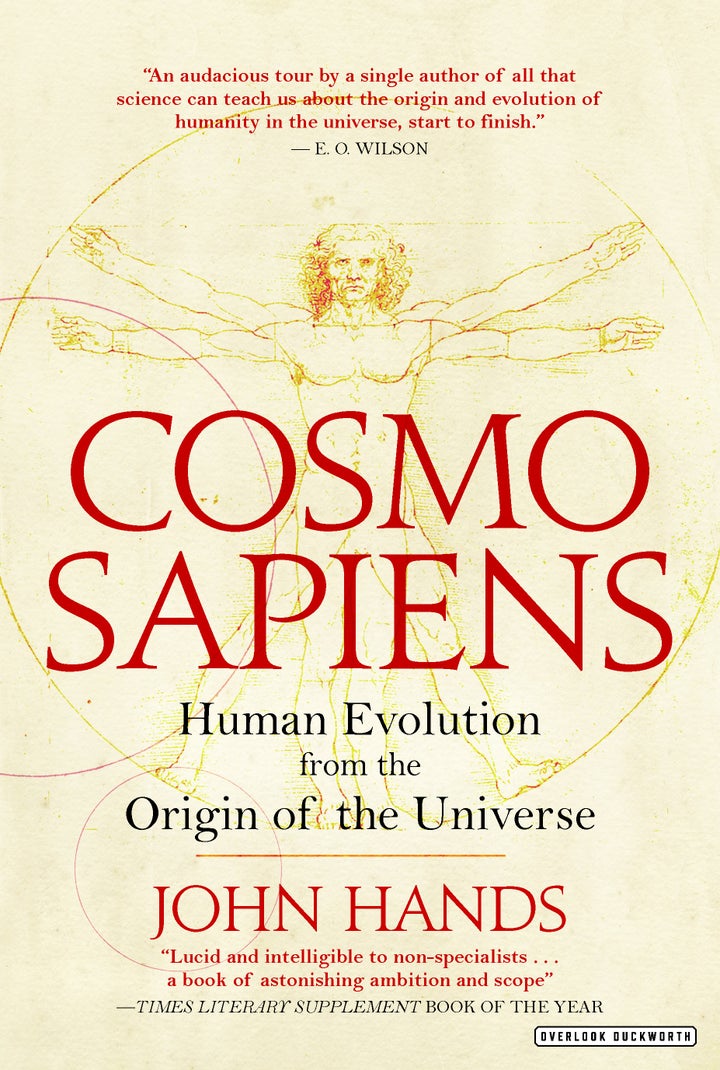
During a visit to California in 1931, Albert Einstein, then living in Europe, asked to meet the famous actor Charlie Chaplin. Chaplin invited him to the premier of the film "City Lights." As they posed for photographers, Chaplin commented, "They cheer for me because they all understand me and they cheer for you because nobody understands you."
People are still curious but confused about science. Thankfully, John Hands has written an intelligent person’s guide to demystify science for the non-specialist reader. Cosmosapiens: Human Evolution from the Origin of the Universe (New York: Overlook Press, October 2017, paperback, $22.95) is a handy tour guide that will provide you with everything you’ve ever wanted to know about the big questions that scientists have sought to answer. To simplify the trip, Hands has divided the tour into three parts: First, how did the universe start and evolve? Second, how did life start and evolve? Finally, how did human beings emerge and evolve?
The military historian Yuval Noah Harari claims to cover some of the same ground in his 2015 book Sapiens: A Brief History of Humankind. But unlike Harari’s book, which is filled with errors, Cosmosapiens has been endorsed by leading scientists and philosophers. Here you will learn that hunter-gatherers did not live peacefully with each other and their neighbors and that the agricultural revolution was not a tragedy for the human species. In Cosmosapiens, you will find the scientific explanation of how and why humans came to dominate the planet.
No less an eminent scientist than Harvard Professor and two-time Pulitzer Prize winner Edward O. Wilson says: “Cosmosapiens is an audacious tour by a single author of all that science can teach us about the origin and evolution of humanity in the universe, start to finish.”
Science has become so specialized and esoteric that few scientists have the capacity to cross disciplinary borders and explain the disputes among scientists and their implications for our civilization. So we have to rely on scientists who are able to translate science for the general public and hope that they aren’t leading us astray. In the past half-century, only a handful of such experts – including Rachel Carson, Carl Sagan, Barry Commoner, Bill Nye, and Neil deGrasse Tyson – have succeeded in reaching a wide audience.
To that list we can now add John Hands. But he goes further than explaining current orthodox scientific theories. Cosmosapiens reminds us that a scientific explanation differs from either a philosophical explanation based on reasoning or insight and a religious explanation based on belief. A scientific explanation results from systematic, repeatable observation or experiment from which a theory is derived that can be used to make verifiable predictions. If new data are discovered that contradict a scientific theory, the theory is either modified to take account of the new data or else rejected in favor of a new theory that explains all the data. That is how science should work.
As Hands points out, however, science doesn’t always live up to those standards. For example, about 70 years ago, observational evidence began contradicting the basic Big Bang theory of the origin of the universe. Cosmologists continually attempted to modify the theory as more evidence produced yet more contradictions. The latest orthodox version invokes Dark Matter to account for 27 per cent of the universe. But 30 years of scientific investigation have failed to identify this Dark Matter.
When Hands delves into biological evolution, he is on grounds that most readers will know something about, even if in simplistic terms, such as the phrase “survival of the fittest.” The Charles Darwin that Hands describes is a more interesting figure than the one we know from popular culture. Like evolution itself, our understanding of Darwin has changed over time. Hands points out that Darwin’s main ideas have been incorporated by American and British biologists into a mathematical model he calls “NeoDarwinism.”
This was popularized by Richard Dawkins in his bestselling 1976 book, The Selfish Gene. It says that biological evolution is caused by genes selfishly competing with each other to survive and replicate. But, according to Hands, this idea is based on the fallacy of ascribing intention to lengths of deoxyribonucleic acid (DNA) of which genes are composed. Dawkins admits that this language is sloppy and he could express it in scientific terms, but he never does. Moreover, Hands says, it is contradicted by substantial 21st Century behavioral, genetic, and genomic evidence. When confronted by such evidence, instead of modifying the theory to take account of the evidence, as a scientist should do, Dawkins lamely responded that “genes must have misfired.” In fact he couldn’t modify the theory because the evidence shows that Darwinian competition causes not the evolution of species but the destruction of species. That evidence leads Hands to propose (on page 423) four laws of biological evolution.
Echoing Thomas Kuhn’s pioneering The Structure of Scientific Revolutions, Hands says the reason that some scientific theories become established dogma, despite evidence contradicting them, is that scientists are no different from other people, with the same ambitions, insecurities, and fallibilities. They believe in a theory on which they have worked for most of their professional lives and tend to ignore or dismiss contradictory evidence. Leading proponents of a theory teach it to undergraduate students. They decide which students are accepted for research degrees, which research receives funding, which papers are published in scientific journals, and which researchers are promoted to university posts. It creates a culture in which it is difficult for junior researchers to challenge the theory if they want a career in science.
Hands points out that even distinguished scientists, like Geoffrey Burbidge (winner of the Royal Astronomical Society’s Gold Medal) and evolutionary biologist Lynn Margulis (whose many awards include the President’s National Medal of Science), repeatedly complained that for part of their careers they were refused publication in mainstream scientific journals because they proposed alternatives to the orthodox theories in their fields.
Paradoxically, scientists ignoring or denying evidence that contradicts their dogma produce adverse consequences. First, it holds up progress in science. Second, in biology, for example, it provides ammunition to religious fundamentalists who challenge the very idea of evolution, the evidence for which, Hands says, is irrefutable.
In the third part of Cosmosapiens, Hands attempts to answer the question that scientists, philosophers, and theologians have been asking for centuries: what does it mean to be human?
His examination of the evidence leads to a conclusion that he had hadn’t anticipated, and is perhaps the most striking part of the book.
The evolution of the human lineage, from the simplest ancient animals like hydra, is marked by a growth in complexity and centration in which neurons — the nerve cells —become increasingly centered in a brain. This increasing complexity and centration corresponds with increasing consciousness. What makes humans different is that this rise in consciousness reaches the point that it becomes conscious of itself. Humans not only know, but we also know that we know. We reflect on ourselves and our place in the cosmos. We ask questions like: What are we? Where did we come from? Why do we exist? This reflective consciousness marks a difference in kind, not merely in degree, from other animals.
Moreover, we are continuing to evolve, but this evolution is not primarily a change in physical appearance or in our genes, but in our minds. According to Hands, this evolution of self-reflective consciousness, or mental evolution, has been accelerating since humans first emerged some 25,000 years ago. In the last 65 years it has produced extremely rapid developments in technology that have led to globalization, both physically and electronically, in trade, science, education, and politics. It has produced an increase in complexity of human societies beyond the family, a reduction in aggression, and an increase in cooperation. And it has given us the unique ability to determine our own future evolution, for good or for ill. Hands even argues that the founding of the United Nations and altruistic groups like Doctors Without Borders is evidence of such mental evolution.
Human’s unique capacity for self-reflective consciousness explains how we came to dominate the planet and engage in activities way beyond those needed for survival and reproduction, like composing symphonies and cooperating to send spacecraft to explore our solar system and beyond. Yet, Hands cautions, this self-reflective consciousness is struggling with instincts of aggression and competition inherited from several million years of pre-human ancestry.
Every reader will have at least a few “aha” moments in this book, whispering to him/herself, “I never knew that “ or “I’d never looked at it that way before.” The book will surely whet readers’ appetite to learn more. Fortunately, Hands provides an extensive bibliography and glossary of terms that will help readers without much scientific background and who want to explore some topics in greater depth.
Readers will be grateful that Hands writes clearly and concisely. He has taught writing, as well as physics, at the university level and has written three highly praised novels. Given his experience as the founding Director of the Government’s Co-operative Housing Agency and his service on three Government committees, it is not surprising that Hands helps us understand that scientists’ competition for recognition, power, and influence is not unlike competition among politicians.
It is rare to find an individual with Hands’ breadth of knowledge about so many scientific fields. He is an intellectual bridge-builder, able to make connections among a variety of disciplines because he has avoided the tunnel vision that afflicts so many academics and intellectuals in our age of specialization.
Hands’ Cosmosapiens is breathtaking in scope. But he has organized the book in ways that make it easy to follow, including summaries of the scientific arguments and evidence as well as many helpful illustrations, charts, and tables. In his final chapter Hands provides a summary of his key findings in 32 points. A reader might even want to begin there and then go back to the book’s beginning to see how he reaches those conclusions.
Hands obviously loves science, but he is a concerned lover who recognizes the limitations of science. He has the humility to accept that the more we know, the more we understand how much we do not know.
This groundbreaking book will surely become a classic of scientific thinking. It should be on the shelf of anyone who has ever asked “What are we?” and “Why are we here?”
Peter Dreier teaches Politics and chairs the Urban & Environmental Policy Department at Occidental College. His most recent book is The 100 Greatest Americans of the 20th Century: A Social Justice Hall of Fame (Nation Books).
